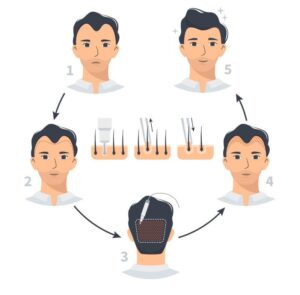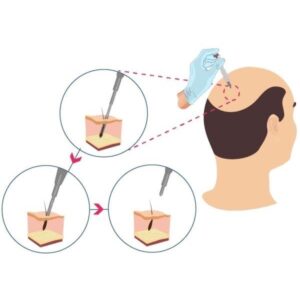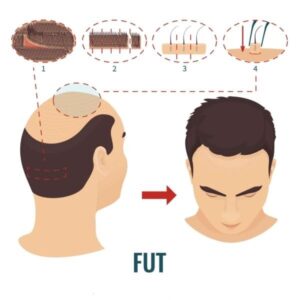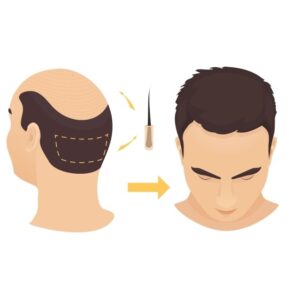
Effective methods of getting rid of alopecia areata
Alopecia is a widespread condition. According to statistics, by the age of 35, two-thirds of men already suffer from thinning hair, and by the age of 50 – 85% of them already have a pronounced degree of alopecia. Women are also affected by this problem: by the age of 50, 40% of them experience noticeable hair loss.
The only effective treatment for baldness that can provide long-term results is hair transplantation. Several transplant techniques are currently available, each with its unique features. If you are faced with the question of whether DHI or FUE is better, the Beauty by Experts Medical team has compiled the most up-to-date information on these transplant techniques for you. This article is sure to help you make the right choice.
What is a FUE hair transplant?

If you’re thinking about comparing DHI vs FUE, it’s worth taking a closer look at these techniques. This way, you can fully appreciate their benefits.
FUE (Follicular Unit Extraction) is a method where individual follicles are extracted from the donor area and transplanted into the recipient area. It is a fairly popular procedure that suits most patients.
FUE was a real breakthrough in the field of hair transplantation. Before it, the surgery was performed using the flap method of FUT. A strip of skin with hair was removed from the donor area, divided into grafts (fragments of skin with follicles), and then transplanted into the area of baldness. This was a traumatic approach, requiring a long recovery time and associated with the risk of severe scarring.
The FUE technique has fundamentally changed the approach to hair transplantation. The surgeon can now isolate grafts with follicles directly from the scalp using small incisions. The grafts are placed in a saline solution. The doctor then uses a scalpel to make channels in the recipient area and implants the follicles. No noticeable scars are left after the surgery, and the patient recovers quickly.
At the preliminary stage of choosing DHI vs FUE, it can be said that FUE is an effective and safe method of hair transplantation that produces excellent results.
What is DHI hair transplantation?

DHI (direct hair implantation) is a modification of the FUE method introduced by DHI Global Medical Group in 2010. The two techniques are generally similar, but they have a key difference.
During a DHI transplant, as with FUE, the surgeon extracts each follicle individually from the donor area. This is usually the side of the back of the head, as this is where the hair follicles are more resistant to the hormones that are the main cause of hair loss in androgenetic alopecia.
Next comes the hair implantation stage. If you want to understand the difference between DHI and FUE, this is the one to pay special attention to. The obtained grafts are loaded into a special Choi implanter (an instrument that looks like a pen) and transplanted into the recipient area with its help. The doctor does not need to open channels in the scalp beforehand. He does this with the Choi device. Therefore, the hair transplant procedure is called direct hair transplantation. If we consider the FUE vs DHI hair transplant methods, the use of an implant is the main difference between them, but only the difference between them.
Advantages of using an implanter in DHI hair transplant procedure

The use of the Choi pen reduces the procedure time. It also helps to protect the fragile follicles during transplantation, thus ensuring better hair engraftment. Finally, with the implanter, the surgeon can implant the follicles with greater precision, respecting the depth, natural angle and direction of hair growth. The patient’s recovery period after DHI transplantation is slightly shorter than with FUE.
Additional advantages of this technique include:
- Reduced scalp manipulation in the recipient area. With the FUE technique, the surgeon first opens the canals and only then implants the follicles. The DHI method allows the two procedures to be combined in one step, which means less scalp trauma and faster healing.
- The ability to choose different graft sizes. The amount of hair in the follicles varies depending on the area of the head where they are located. For example, the upper area is the thickest with 2-4 hairs in the follicles, the top of the head has 2-3, and the temples and back of the head have 1-2. The different sizes of the Choi implanter allow you to transplant the number of hairs that corresponds to the growth zone. In this way, it is possible to get the most natural result. This is a point worth noting when comparing DHI vs FUE.
- Greater density of transplanted hair. With the Choi implanter, the doctor can place the grafts closer together, achieving a higher density and a more natural look for the future hairstyle.
- Greater follicle survival rate. Hair grafts are very susceptible to mechanical damage. Therefore, not all of the grafts extracted survive. The Choi pen protects the follicles from external influences. Therefore, it can be used to transplant more hair successfully.
FUE vs DHI hair transplant: key differences
For a clear comparison of DHI vs FUE, let’s briefly summarize the key differences between these hair transplant methods.
- Success rate. Both techniques offer a high success rate of transplantation. FUE has a success rate of 95% or higher, while DHI has a success rate of 98% or higher.
- Density of transplanted hair. The DHI method allows you to achieve a slightly higher density of hair. However, much depends on the professionalism and experience of the surgeon.
- Accuracy of transplantation. It is higher with DHI due to the use of the Choi implant.
- The presence of scars. Both transplant options do not leave noticeable scars.
- Rehabilitation period. Healing is faster with DHI hair transplantation due to less scalp trauma.
- Graft survival rate. Higher with DHI because the follicles are protected by the walls of the hollow needle of the Choi implant pen during transfer.
- Duration of procedure. It is faster with DHI because the physician does not need to pre-create canals before transfer.
- Cost. FUE transplantation is slightly less expensive, as the DHI procedure requires the surgeon’s skill and the use of a Choi implant.
- It can be used to improve the overall appearance of the hair. Some women turn to a hair transplant specialist when they want to add density to the hair in the most noticeable areas of the head. Since DHI allows for greater density, this technique is better suited for this purpose.
How do I get the desired DHI or FUE hair transplant results?
Both techniques can provide good results with the right choice of specialist and clinic. However, if the price difference of €150 is not critical, it is still better to choose the DHI method. There are many medical centers in Turkey offering hair transplantation; however, not all of them guarantee the quality of the treatment.
Beauty by Experts Medical has cooperated with the best Turkish clinics for over 8 years. We know exactly which medical center to turn to in order to get an excellent result. Experts from leading hair transplant clinics such as Istanbul Aesthetic, Cosmedica, Turkeyana and others work with us. These are medical centers whose reputation and reviews of satisfied patients speak for themselves. Leave a request on the website and we will find the best center for hair transplantation for you.
FUE vs FUT vs DHI: comparing the three hair transplant methods

The comparison of FUE vs FUT vs DHI should start with the fact that the FUT method is no longer practically used. It involves removing a flap of skin from the back of the patient’s head, dividing it into grafts and then transplanting the follicles into the area of baldness. In the leading hair transplant clinics in Turkey, there is no question of choosing FUE vs FUT vs DHI, as FUT is a highly traumatic method of hair transplantation. Its disadvantages include:
- The need to stitch the donor area after surgery;
- great pain and a long rehabilitation period;
- pronounced scarring in the donor area.
Removal of entire strips of skin limits the possibility of repeated hair transplantation in the future if the patient needs a small correction in a few years. In addition, after FUT transplantation, people have to choose a haircut that will hide the scar on the back of the head. Therefore, when comparing FUE vs FUT vs DHI, the advantage remains on the side of the newer and less invasive techniques.
FUE vs DHI hair transplantation: when is FUE better and when is DHI better?

When comparing DHI vs FUE, it is important to consider the purpose for which a particular hair transplant method is used.
DHI is better suited for people who desire a higher density of transplanted hair and a more natural-looking result. This technique is ideal for patients with small areas of hair loss or thinning hair.
At the same time, FUE is recommended for people with large areas of baldness. Although the density of the transplanted hair will be somewhat lower with this technique, it still allows for an excellent aesthetic result.
Another criterion for choosing DHI vs FUE is the need to shave the hair before transplantation. Currently, both techniques allow you to do without this procedure. This is especially important for women who are often hesitant to undergo hair transplantation due to the need to wear a short haircut.
Thus, choosing between types of hair transplants depends on a person’s unique needs and expectations of the procedure. To understand which is better DHI vs FUE, it is worth enlisting the support of a professional. Leave a message online and a Beauty by Experts Medical coordinating physician will help you schedule a consultation with one of Turkey’s leading hair transplant specialists – Oya Şişman, Levent Akar or Sait Birkan. Expert opinion will help you make an informed decision and choose a technique that will help you achieve the desired result.
DHI vs FUE hair transplant: results
The results of FUE hair transplantation depend mainly on the stage of opening the channels. The hair will look natural if the surgeon creates them at the right angle.
After the FUE procedure, hair begins to grow immediately. After 6 months, they fall out and new ones grow in their place. The final result can be evaluated after 12-18 months.
If we compare the results of DHI vs FUE, direct transplantation allows you to achieve a thicker hair. In addition, due to the use of implants, the follicles are placed at the right depth and angle. Therefore, the transplanted hair looks as natural as possible. Similar to FUE, the final result of DHI should be evaluated after about a year.
The results of DHI vs FUE are about the same in terms of effectiveness. DHI has a higher follicle survival rate. However, much depends on the skill of the surgeon. With the right skills, an experienced doctor manipulates the grafts very carefully, allowing him or her to achieve the same level of success with FUE as with DHI.
Sapphire hair transplant FUE vs DHI

Hair transplant techniques are constantly improving. New, more effective techniques are emerging, the specifics of which are sometimes difficult to understand. So let’s compare the innovative hair transplant method sapphire FUE vs DHI.
The main difference between sapphire FUE and the standard procedure is the way the channels are opened. Surgeons use a sapphire scalpel for this purpose. Compared to a conventional surgical instrument, it is much sharper and thinner (1 to 1.5 mm).
Another feature to consider when choosing a FUE vs DHI sapphire is the shape of the blade. A regular scalpel has a U-shaped blade, while the sapphire tip resembles the letter V. This blade is less traumatic to the tissue. In addition, it allows the surgeon to create microchannels at the desired angle. Therefore, in terms of invasiveness and natural results, sapphire FUE is not inferior to the DHI technique.
Another very important parameter for comparing Sapphire FUE vs DHI is the number of grafts that can be transplanted. With the DHI technique, 3500-4000 follicles can be transplanted in one session. At the same time, sapphire FUE allows single implantation of 5,000 or more hair. However, it should be taken into account that the cost of transplanting such a number of grafts will be 30% higher.
Micro FUE vs DHI hair transplantation

The Micro FUE vs DHI comparison should start with the fact that Micro FUE is another modification of follicular unit transplantation. The standard approach involves harvesting grafts manually. This method requires a high degree of skill and care on the doctor’s part. Otherwise, it is possible to traumatize the scalp. In addition, the need to manually extract the follicles significantly slows down the grafting process.
In Micro FUE, the surgeon uses a motorized machine with a micro tip to harvest the grafts. It is a thin hollow needle with a diameter of 0.6 to 0.8 mm. The automation of the process saves time. In addition, more grafts can be harvested with the micromotor than with the manual FUE technique. On average, a doctor can extract up to 4,500 grafts in one session.
Experienced transplant specialists know that simply extracting a follicle is not enough to engraft hair. It is important that it is surrounded by sebaceous glands and connective tissue. When harvesting grafts with a scalpel and tweezers, there is a high risk of damaging the structures vital to the hair.
With a special instrument whose action is based on vibration and suction, the follicles for transplantation can be gently harvested, minimizing the chance of damage. This is an important aspect of choosing between Micro FUE vs DHI. The use of a micromotor can speed up the FUE procedure and increase follicle survival rates. This makes the effectiveness and success rate of these two methods almost equal.
Let’s summarize: which hair transplant method will produce the best results?
Only an experienced specialist can say exactly which method of hair transplantation will be better than FUE vs DHI in your particular case. Much depends on the initial condition of the hair and the desired result. At the consultation, the doctor will assess in detail the degree of hair loss and identify the areas that need transplantation. After that, he will choose a technique with which to achieve the most effective and maximally natural result.
To find a good specialist, leave a request on this website. Beauty by Experts Medical collaborates with the best doctors of different medical specialties. We will select a doctor and clinic for you, tailored to your individual needs and wishes.
When you contact Beauty by Experts Medical, you receive unique benefits. Our coordinating doctors will take care of all organizational issues and will accompany you at every stage of treatment. Working with us, you can be sure that your hair transplant surgery will be carried out exactly according to the plan developed down to the smallest detail. And you will not encounter unpleasant surprises in the form of a change of doctor or an increase in the previously agreed price for treatment. Beauty by Experts Medical’s primary goal is to ensure your comfort and safety during your hair transplant procedure.
Sources:
- https://www.healthline.com/health/dhi-hair-transplant
- https://www.betterhealth.vic.gov.au/health/conditionsandtreatments/hair-transplant-surgery
- https://www.nhs.uk/conditions/cosmetic-procedures/cosmetic-surgery/hair-transplant/
- https://www.pennmedicine.org/for-patients-and-visitors/find-a-program-or-service/hair-transplantation/frequently-asked-questions




